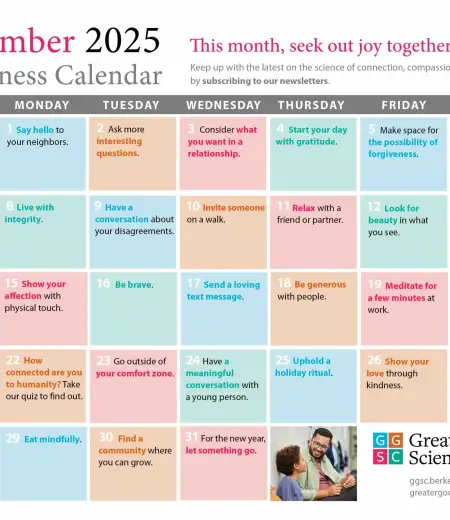After 30 years in health care, I was ready to retire. But instead I found myself walking into a classroom at the Stanford University School of Medicine for the first day of a teacher-training program at the Center for Compassion, Altruism, Research and Education. I was about to learn a new model for teaching the cultivation of compassion.
As a Buddhist practitioner, I had always believed that the transformation of the mind and heart was possible for every human being. It was clear to me that these contemplative practices that I had known personally to be transformative could change health care. But only recently has scientific evidence emerged that validated these beliefs.

That’s why in 2008, Stanford launched a dialogue between experts in the contemplative traditions, principally Tibetan Buddhism, and Western scientists from a variety of fields. I postponed my retirement to help spread one of the results of that dialogue: the Compassion Cultivation Training (CCT), a secular model for helping people develop resilience in the face of suffering.
To me, such a program is timely and necessary: Health care providers have always confronted pain as part of their jobs, but today they must navigate a changing landscape that makes it more difficult than ever to sustain compassion over the long run. The emergence of compassion training holds the promise of helping health care meet those challenges.
Fighting burnout
Health care in the United States is facing major changes. As the health care train barrels full speed into the future, some think that it is a train wreck in slow motion. Even if it is not, health care givers may experience it that way. Not only are there political and financial challenges to transforming care for the US population, but ominously the care delivery system could end up with wounded or absent caregivers.
Already this may be the case. In 2012, JAMA Internal Medicine published the first comprehensive study of physician burnout—and found that 46 percent reported at least one symptom of burnout, especially those who work on the front line of care.
Indeed, research suggests that physicians are more likely to burn out than any other category of workers in the US. And according to various studies, at least one-third of nurses who work in high-risk settings may be suffering from burnout at any given time. This has implications for patients: There may be a relationship between the symptoms of compassion fatigue and the risk of committing medical errors and patient dissatisfaction with care.
Why should this be such an issue? Constant exposure to pain and suffering is an occupational risk intrinsic to health care. A case may be made that working in high-risk health care settings is similar in some ways to battlefield combat: prolonged stress, risk and complexity that degrades working memory, emotional regulation, and can result in secondary trauma or PTSD. These issues will never go away.
But there is much about the current economic and policy climate that actually puts health care workers at greater risk for burnout. As we address the issues of health care quality, safety, retention, access and funding, we also introduce complexity, time constraints, volume, and demands for new knowledge and skills for people in health care.
To cope with the future, health care professionals will need new resilience in the face of suffering, expanded capabilities to pay attention in more complex environments, and greater emotional intelligence in their relationships to care for others while also caring for themselves.
Training for compassion
In recent years, the science of compassion has made enormous strides. We are beginning to understand that compassion brings mental and physical health benefits to those who feel it—and research also suggests that compassion is a skill we can strengthen through training. The Center for Compassion, Altruism Research and Education (CCARE) at Stanford University School of Medicine was founded on this understanding that compassion can be cultivated by every human being—and that applications to the fields of education, medicine, business and government could profoundly change our lives.
CCARE developed the Compassion Cultivation Training (CCT) in collaboration with Thupten Jinpa, Tibetan scholar and principal translator for the Dalai Lama, and senior researchers at Stanford. It consists of Six Steps that gradually help participants develop the cognitive, emotional, and behavioral elements of the skills of compassion—which we define as the intention or wish and action to relieve suffering. Through progressive experiential training, it helps participants to compassionately focus on a loved one, then move that focus to oneself, to the stranger, to the difficult person, and then to all living beings.
Through strengthening of intention and attention, awareness of body sensations, cultivation of loving-kindness for self and others, and offering a vision of shared common humanity, CCT facilitates a transformation of how people relate and respond to their own suffering and to that of others.
CCT consists of nine weekly two-hour classes that include lectures, guided compassion cultivation exercises, and group discussions. The class is cumulative so that each session builds on the previous sessions. The goal of the training is to provide a practical framework for developing compassion for one’s self and others. The CCT teacher-training manual suggests that cultivating compassion may lead to improved communication, increased resilience to stress, and enhanced feelings of well‐being.
Cultivating compassion in hospitals
In 2011 we introduced the first Compassion Cultivation Training at Sharp Health care in San Diego, California. Sharp Health care is a regional nonprofit with seven hospitals, two medical groups, a health plan, 2600 physicians, and 15,000 employees.
We approached the introduction of CCT into Sharp Health care with a strategy of bottom up and “organic” development, assuming that the positive results for individuals would spread by word of mouth, touching the deepest personal needs of employees struggling with the challenges of health care delivery.
We were right. We held the first classes in the Sharp Memorial Hospital Rehabilitation conference room for 25 participants who heard about the program by word of mouth. The class was free and taken on employees’ free time. We selectively invited key Sharp leaders in order to develop CCT champions within corporate leadership. By the second series of classes we had waiting lists and the strong interest from leaders in clinical and administrative departments.

We are now teaching our third nine-week series of two classes per week. We have trained over 150 Sharp employees and some community members. Participants have been nurses, physicians, directors, CEOs, social workers, physical therapists, chaplains, IT and finance employees. From the community have come educators, a chef, massage therapist, executive coach, and therapists of different disciplines. We are now able to offer CEU, CME, and CPE credits. We have interest from three university research departments to partner with us to begin research on the applications and effectiveness of CCT.
Although we think that all of this is a measure of early success, the stories of transformation from our participants are the real evidence of success.
It is the chaplain with 25 years of experience who confessed to burnout from death and dying in the emergency rooms; after CCT this chaplain abandoned plans to change jobs , experiencing an ability to be present with the pain of patients and be energized by the work of relieving suffering. It is the older physician observed by nursing staff to hold the hand of a patient for maybe the first time. It is the director of corporate finance, whose focus is admittedly on the “bottom line,” who is implementing mindfulness and compassion training so that employees have a healthier work environment and the skills to manage their work stress.
There are countless reported stories of participants experiencing compassion that changes work, family and marital relationships, feelings about their own self-worth, management of physical pain, relief from anxiety, and deepening of religious faith and spiritual practice. The monthly follow up class for CCT graduates has become a community that supports the motivation and continued growth in the practice of cultivating compassion.
The success of CCT at Sharp Health care is anecdotal, but real. We trust that future research in our program will join with the work being done at Stanford CCARE and other academic centers to identify the evidenced based practices of compassion that empower people to meet the challenges of the future. Health care does not have to be a train wreck. It can be an opportunity for people in health care to thrive, even as they relieve the suffering of others.








Comments
Fantastic article by my wonderful friend and
colleague, Bob McClure. What a treat to have such
thoughtful insight into how to better serve care
providers, patients and health care communities.
Compassion!
Emiliana Simon-Thomas | 12:16 pm, February 28, 2013 | Link
Thank you for sharing your inspiring work. I will share this
with healthcare staff in the uk.
Wendy Wood | 12:38 pm, March 2, 2013 | Link
Thank you for this wonderful article. I am currently
writing a research proposal for my dissertation about
compassion in mental health nursing. I am
hypothesizing that loving kindness meditation can be
used to combat compassion fatigue, so this article is
so relevant. I am stumbling over measures for
compassion though, I have found some measures for
self-compassion, but apart from MRI scanning, I am
at a loss. Can anybody point me in the right
direction? .(JavaScript must be enabled to view this email address) Thanks again 😊
natalie reeve | 11:53 am, March 3, 2013 | Link